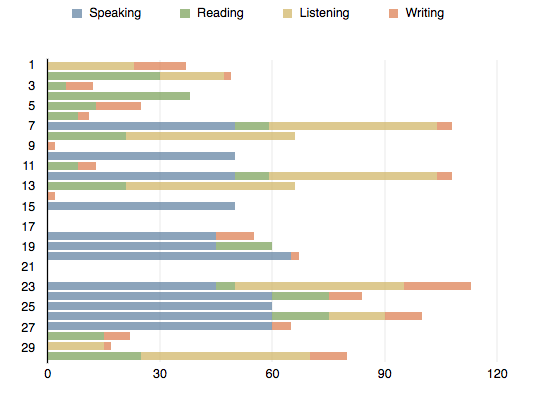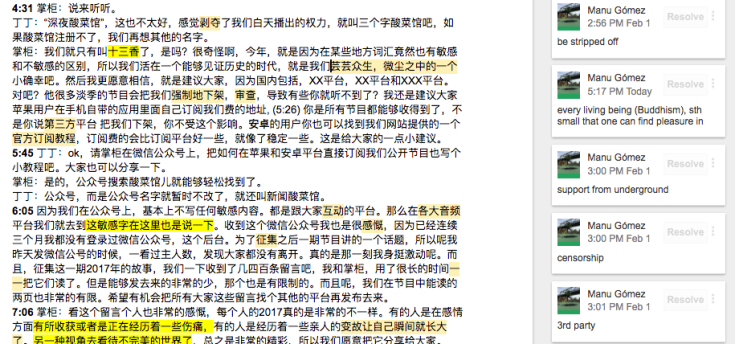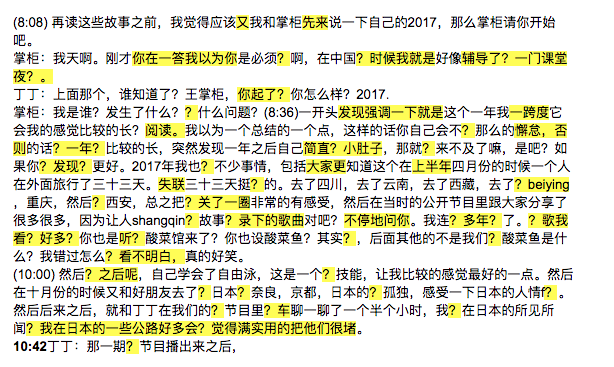If you’ve read my posts from the beginning of the year, you probably saw that I started a 100 Days of Chinese Challenge back in January. I did a check-in at the 10 day mark and saw that the challenge had been working at least in getting me started. Now, a month in things are starting to get really interesting. So, what’s been happening?
After the two week mark there was a slight dip in study time and I had 4 nonconsecutive days in one week in which I didn’t study at all. That goes to show you, life happens. But the other thing to learn from that is when you track your progress you can clearly see when you’ve been slacking off, for whatever reason. And in this way I managed to motivate myself to put in more effort. How did I do that?

More Speaking
By joining another challenge, that is, italki New Year Language Challenge, I committed to spending more time on speaking. Now, according to my stats, I’ve spent 47% of my study time on speaking. Honestly, being part of a challenge and committing to a minimum amount of hours has had quite a big impact on my progress, especially on hitting that 1hr/day mark.

Speaking class for me is not so much about improving my speaking, since that’s what I spent most of the last year and half on, although I do feel more confident every class. It’s really about the challenge of having class prepared. Because I like using my class time more efficiently than just chatting, it’s important to have some kind of material to use during the class. At the end of last year, I started working on my listening skills by transcribing podcasts. This type of material has shown itself to offer quite a thorough learning opportunity.

The process is simple. I listen to a podcast episode (at the moment from 新闻酸菜馆) and transcribe a little bit and whatever I don’t understand I leave highlighted and add a question mark. I repeat this on a 2-3 minute interval until I feel like I cannot possibly correct it any longer. The whole process takes me about 45 min. Right before class, I send my transcription and the teacher only takes about 5 minutes of class time transcribing what I missed. Then, we read over the transcript and I ask about certain ways of speaking, vocabulary, meaning, etc. and leave comments on the document. At the end of the class I’ll listen to those 2-3 minutes again with the transcript in hand. It’s a slow process, but the results for me have been phenomenal with my listening ability improving pretty much on a daily basis.


One of the interesting points about there being no previous transcript is that I can also gauge with my teacher how hard the transcription is. In the one above, the guy (掌柜) is from the south and doesn’t have a standard accent, he speaks almost mumbling and it takes me many times before I kind of figure out half of what he’s saying. I wouldn’t really have known this off the bat if it were not for one of my teachers actually commenting on his accent and having trouble himself correcting the transcription. On a side note, one of my teachers is not particularly good at explaining the grammar, so I mostly just stick to chatting with him about random things, but that’s good, too because it’s a relaxed kind of chat.
One of the last things to say about transcribing this podcast is getting really familiar with how people express themselves more naturally in Chinese, including slang as well as humor. For example, there’s a lot of articles about how to use particles at the end of the sentence, or how Chinese people are always saying 那个, but with this podcast you can also see there’s others like 就是,那么,这个, etc. The prevalence of these kind of linguistic crutches really shows you another side to the language.
Graded Readers
Since this month focus is mainly on listening/speaking, I’ve also given myself a break from the reading material I was using at the beginning of the challenge. In terms of difficulty level, it was up there with the podcast transcription. But because I don’t want to get burnt out I went back to reading material at my level, ie, working with comprehensible input.

For reading, comprehensible input means graded readers. A while back, I bought two graded readers for Advanced Beginning Students, but I hadn’t read all the stories. So now I’m going through re-reading all the stories I had already read and reading some of the ones I hadn’t. The words I usually don’t know are at most 3 or 4, but the point of this exercise is not to look up a bunch of words in the dictionary and make a vocabulary list to use later, but instead to see the language being used in this format and seeing words you already know used in context, which is why graded readers are so important!
I sit back on my hammock and read two or three stories, paying close attention to grammar and sentence structure. But more importantly, I enjoy the story. And I have to say, the stories are actually quite interesting and humorous (and definitely much more easy to read now). Maybe I’ll even write a post on one of my favorites about a frog in a well.
Conclusions
One thing we can learn from this past month is that to keep a steady and consistent habit of language learning it’s crucial to stay as accountable as possible, through tracking, scheduling paid lessons on a regular basis, writing blog posts, and so on. Also, this challenge has taught me to keep it fun and casual as well. I’m the sort of person that feels like if I’m not being challenged I’m not learning, but that’s not really the case. Yes, it’s important to have a focus, a temporary as well as a long-term focus, but the rest of the time can be spent enjoying the language in a comprehensible format and that’s learning, too.
Thoughts?


Leave a comment